ABC Organization: Operational Plan for Cultural Change and Innovation
VerifiedAdded on 2019/10/09
|11
|2596
|166
Report
AI Summary
This report presents an operational plan for ABC organization, focusing on introducing a participative or collaborative decision-making culture. The plan outlines the steps for engaging individuals and groups, including awareness, impact assessment, and addressing resistance. It details current initiatives, such as exit interviews, cultural games, and training programs, which have already yielded positive results. The report also highlights future actions, including successor planning, job rotation, and management performance evaluations based on employee satisfaction. A detailed budget for the change management program is provided, along with a timeline and assigned responsibilities. The review and monitoring mechanism, led by a governing board, ensures the progress of key indicators such as revenue growth, client acquisition, and attrition rates. The report emphasizes the importance of a strategic roadmap to ensure the successful implementation of the new culture, leading to innovation and organizational improvement.
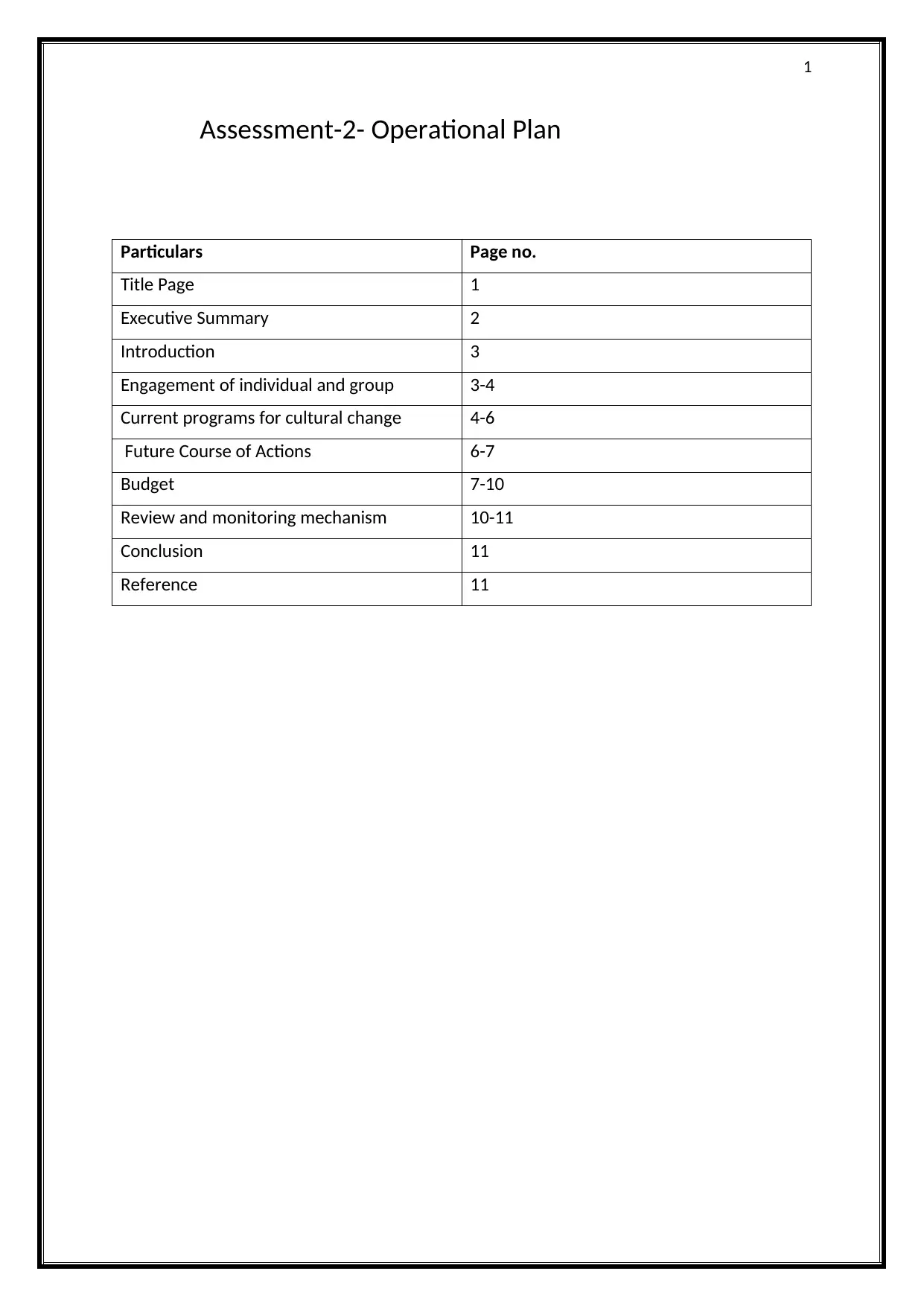
1
Assessment-2- Operational Plan
Particulars Page no.
Title Page 1
Executive Summary 2
Introduction 3
Engagement of individual and group 3-4
Current programs for cultural change 4-6
Future Course of Actions 6-7
Budget 7-10
Review and monitoring mechanism 10-11
Conclusion 11
Reference 11
Assessment-2- Operational Plan
Particulars Page no.
Title Page 1
Executive Summary 2
Introduction 3
Engagement of individual and group 3-4
Current programs for cultural change 4-6
Future Course of Actions 6-7
Budget 7-10
Review and monitoring mechanism 10-11
Conclusion 11
Reference 11
Paraphrase This Document
Need a fresh take? Get an instant paraphrase of this document with our AI Paraphraser
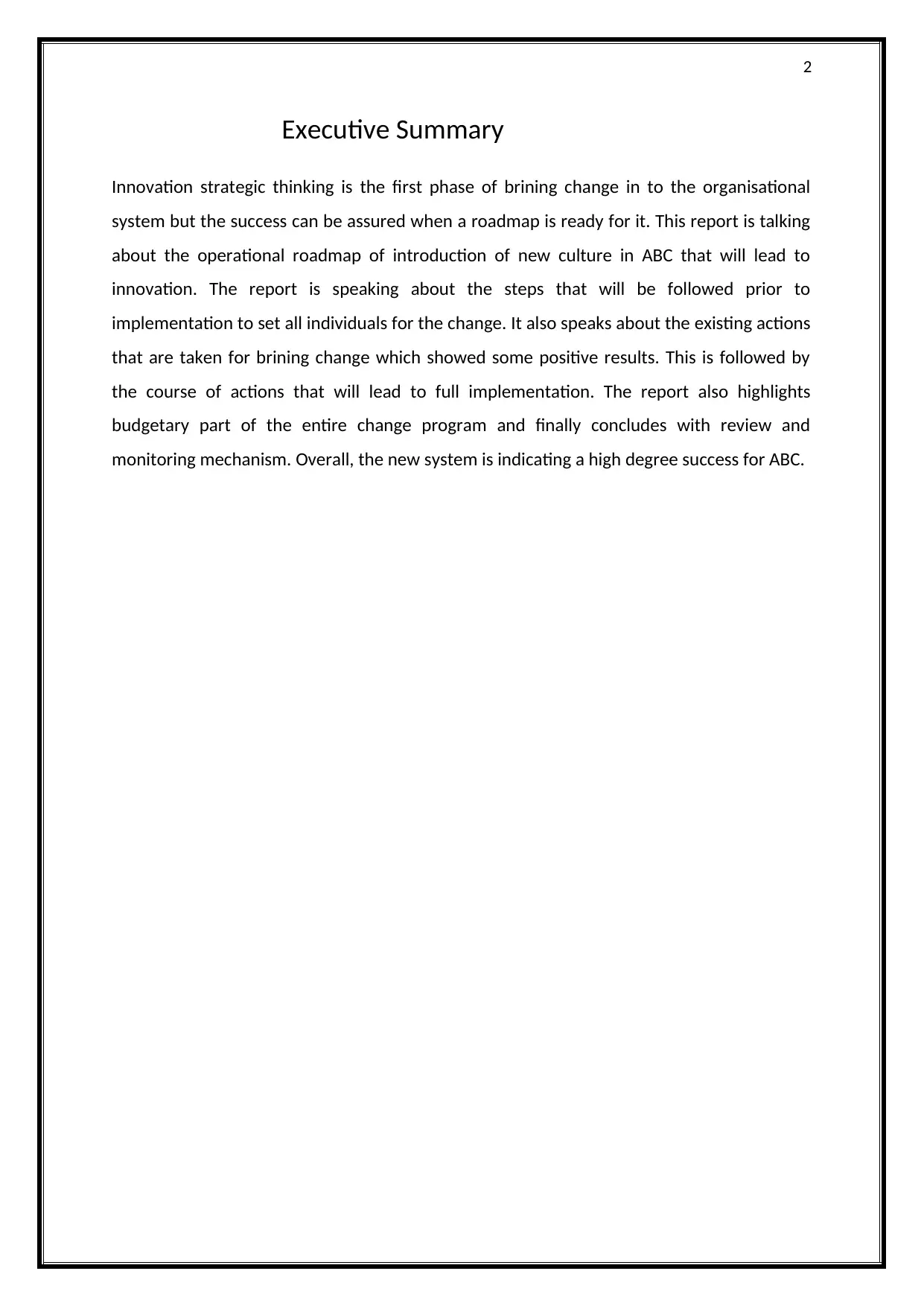
2
Executive Summary
Innovation strategic thinking is the first phase of brining change in to the organisational
system but the success can be assured when a roadmap is ready for it. This report is talking
about the operational roadmap of introduction of new culture in ABC that will lead to
innovation. The report is speaking about the steps that will be followed prior to
implementation to set all individuals for the change. It also speaks about the existing actions
that are taken for brining change which showed some positive results. This is followed by
the course of actions that will lead to full implementation. The report also highlights
budgetary part of the entire change program and finally concludes with review and
monitoring mechanism. Overall, the new system is indicating a high degree success for ABC.
Executive Summary
Innovation strategic thinking is the first phase of brining change in to the organisational
system but the success can be assured when a roadmap is ready for it. This report is talking
about the operational roadmap of introduction of new culture in ABC that will lead to
innovation. The report is speaking about the steps that will be followed prior to
implementation to set all individuals for the change. It also speaks about the existing actions
that are taken for brining change which showed some positive results. This is followed by
the course of actions that will lead to full implementation. The report also highlights
budgetary part of the entire change program and finally concludes with review and
monitoring mechanism. Overall, the new system is indicating a high degree success for ABC.
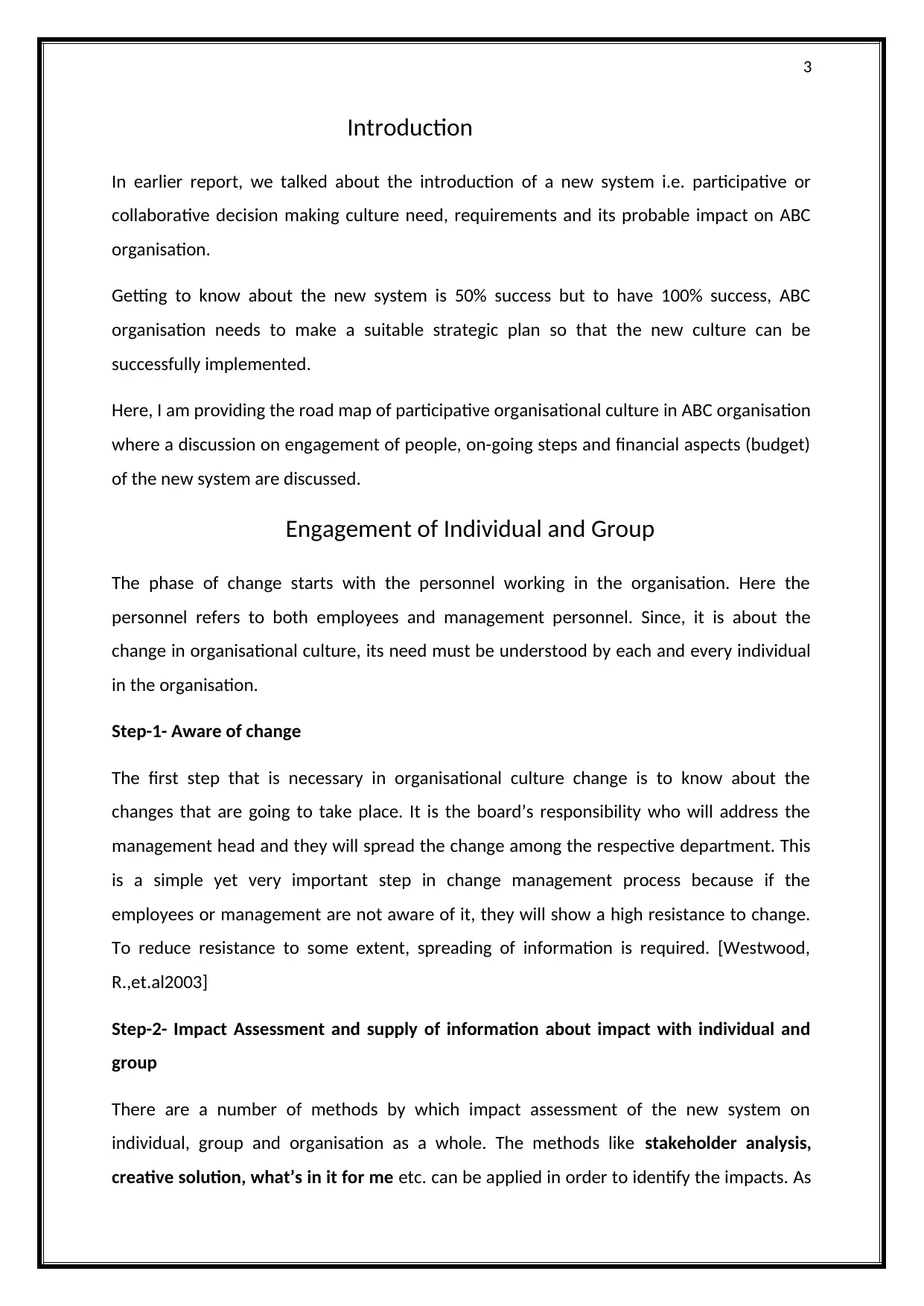
3
Introduction
In earlier report, we talked about the introduction of a new system i.e. participative or
collaborative decision making culture need, requirements and its probable impact on ABC
organisation.
Getting to know about the new system is 50% success but to have 100% success, ABC
organisation needs to make a suitable strategic plan so that the new culture can be
successfully implemented.
Here, I am providing the road map of participative organisational culture in ABC organisation
where a discussion on engagement of people, on-going steps and financial aspects (budget)
of the new system are discussed.
Engagement of Individual and Group
The phase of change starts with the personnel working in the organisation. Here the
personnel refers to both employees and management personnel. Since, it is about the
change in organisational culture, its need must be understood by each and every individual
in the organisation.
Step-1- Aware of change
The first step that is necessary in organisational culture change is to know about the
changes that are going to take place. It is the board’s responsibility who will address the
management head and they will spread the change among the respective department. This
is a simple yet very important step in change management process because if the
employees or management are not aware of it, they will show a high resistance to change.
To reduce resistance to some extent, spreading of information is required. [Westwood,
R.,et.al2003]
Step-2- Impact Assessment and supply of information about impact with individual and
group
There are a number of methods by which impact assessment of the new system on
individual, group and organisation as a whole. The methods like stakeholder analysis,
creative solution, what’s in it for me etc. can be applied in order to identify the impacts. As
Introduction
In earlier report, we talked about the introduction of a new system i.e. participative or
collaborative decision making culture need, requirements and its probable impact on ABC
organisation.
Getting to know about the new system is 50% success but to have 100% success, ABC
organisation needs to make a suitable strategic plan so that the new culture can be
successfully implemented.
Here, I am providing the road map of participative organisational culture in ABC organisation
where a discussion on engagement of people, on-going steps and financial aspects (budget)
of the new system are discussed.
Engagement of Individual and Group
The phase of change starts with the personnel working in the organisation. Here the
personnel refers to both employees and management personnel. Since, it is about the
change in organisational culture, its need must be understood by each and every individual
in the organisation.
Step-1- Aware of change
The first step that is necessary in organisational culture change is to know about the
changes that are going to take place. It is the board’s responsibility who will address the
management head and they will spread the change among the respective department. This
is a simple yet very important step in change management process because if the
employees or management are not aware of it, they will show a high resistance to change.
To reduce resistance to some extent, spreading of information is required. [Westwood,
R.,et.al2003]
Step-2- Impact Assessment and supply of information about impact with individual and
group
There are a number of methods by which impact assessment of the new system on
individual, group and organisation as a whole. The methods like stakeholder analysis,
creative solution, what’s in it for me etc. can be applied in order to identify the impacts. As
⊘ This is a preview!⊘
Do you want full access?
Subscribe today to unlock all pages.

Trusted by 1+ million students worldwide
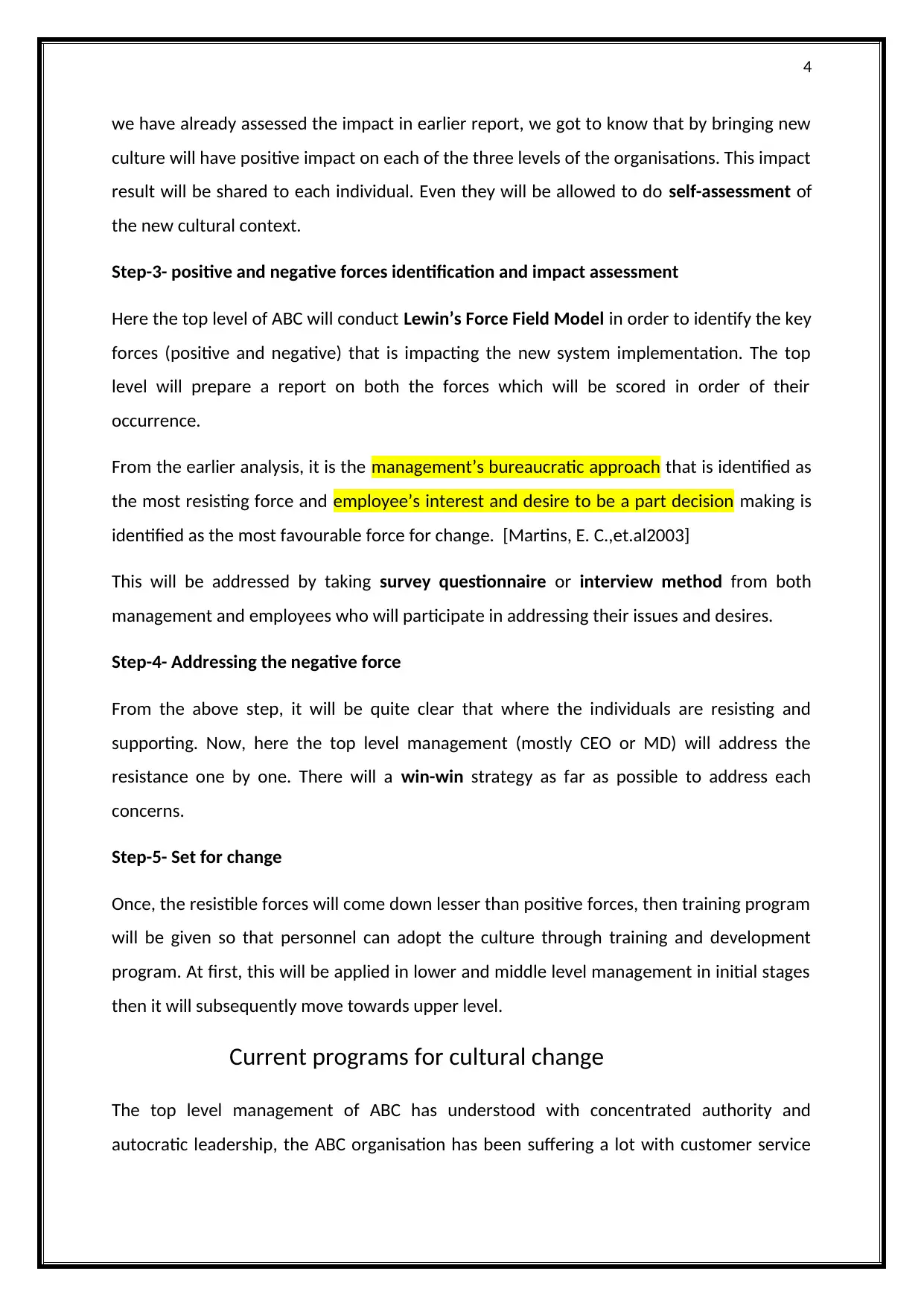
4
we have already assessed the impact in earlier report, we got to know that by bringing new
culture will have positive impact on each of the three levels of the organisations. This impact
result will be shared to each individual. Even they will be allowed to do self-assessment of
the new cultural context.
Step-3- positive and negative forces identification and impact assessment
Here the top level of ABC will conduct Lewin’s Force Field Model in order to identify the key
forces (positive and negative) that is impacting the new system implementation. The top
level will prepare a report on both the forces which will be scored in order of their
occurrence.
From the earlier analysis, it is the management’s bureaucratic approach that is identified as
the most resisting force and employee’s interest and desire to be a part decision making is
identified as the most favourable force for change. [Martins, E. C.,et.al2003]
This will be addressed by taking survey questionnaire or interview method from both
management and employees who will participate in addressing their issues and desires.
Step-4- Addressing the negative force
From the above step, it will be quite clear that where the individuals are resisting and
supporting. Now, here the top level management (mostly CEO or MD) will address the
resistance one by one. There will a win-win strategy as far as possible to address each
concerns.
Step-5- Set for change
Once, the resistible forces will come down lesser than positive forces, then training program
will be given so that personnel can adopt the culture through training and development
program. At first, this will be applied in lower and middle level management in initial stages
then it will subsequently move towards upper level.
Current programs for cultural change
The top level management of ABC has understood with concentrated authority and
autocratic leadership, the ABC organisation has been suffering a lot with customer service
we have already assessed the impact in earlier report, we got to know that by bringing new
culture will have positive impact on each of the three levels of the organisations. This impact
result will be shared to each individual. Even they will be allowed to do self-assessment of
the new cultural context.
Step-3- positive and negative forces identification and impact assessment
Here the top level of ABC will conduct Lewin’s Force Field Model in order to identify the key
forces (positive and negative) that is impacting the new system implementation. The top
level will prepare a report on both the forces which will be scored in order of their
occurrence.
From the earlier analysis, it is the management’s bureaucratic approach that is identified as
the most resisting force and employee’s interest and desire to be a part decision making is
identified as the most favourable force for change. [Martins, E. C.,et.al2003]
This will be addressed by taking survey questionnaire or interview method from both
management and employees who will participate in addressing their issues and desires.
Step-4- Addressing the negative force
From the above step, it will be quite clear that where the individuals are resisting and
supporting. Now, here the top level management (mostly CEO or MD) will address the
resistance one by one. There will a win-win strategy as far as possible to address each
concerns.
Step-5- Set for change
Once, the resistible forces will come down lesser than positive forces, then training program
will be given so that personnel can adopt the culture through training and development
program. At first, this will be applied in lower and middle level management in initial stages
then it will subsequently move towards upper level.
Current programs for cultural change
The top level management of ABC has understood with concentrated authority and
autocratic leadership, the ABC organisation has been suffering a lot with customer service
Paraphrase This Document
Need a fresh take? Get an instant paraphrase of this document with our AI Paraphraser
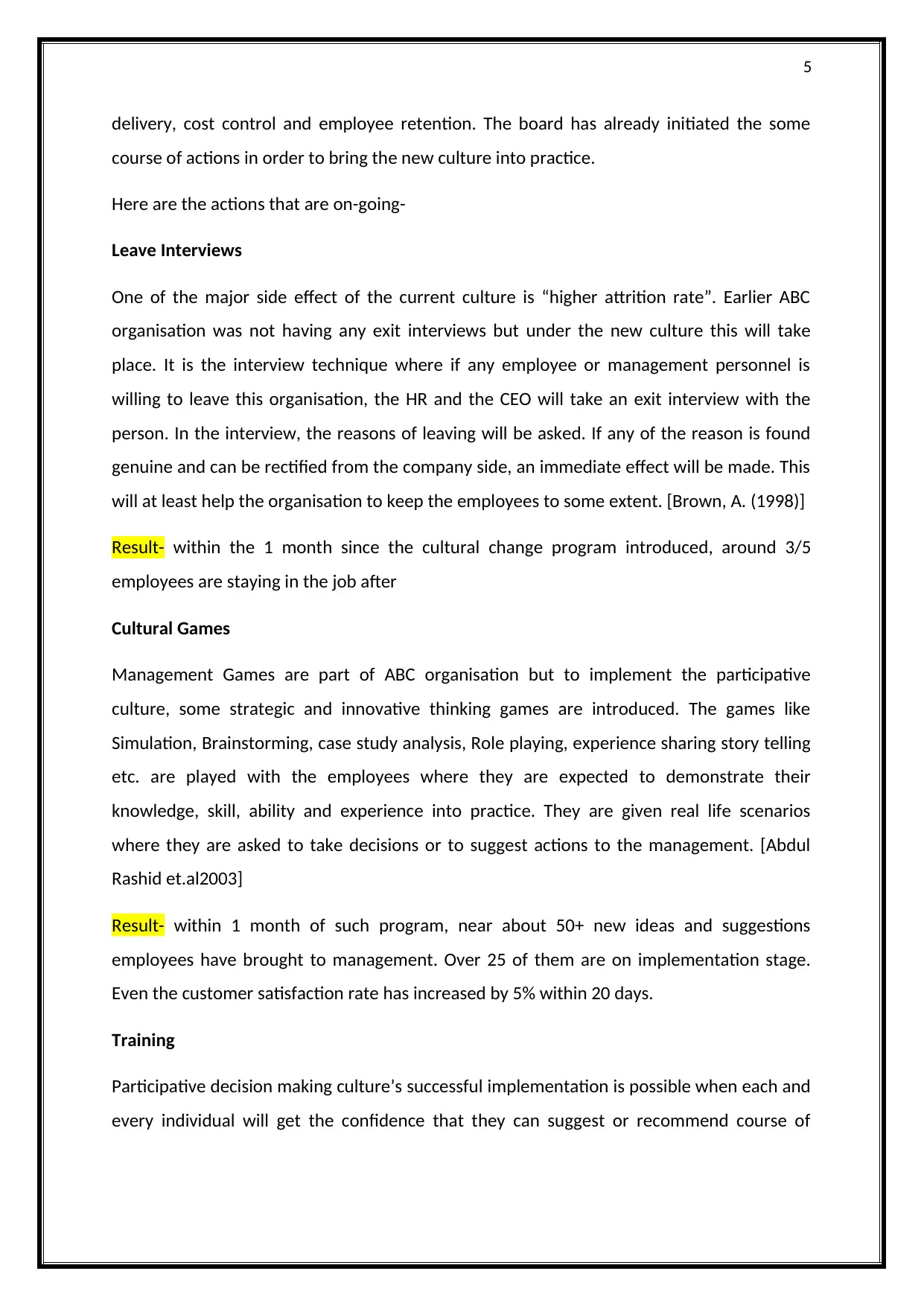
5
delivery, cost control and employee retention. The board has already initiated the some
course of actions in order to bring the new culture into practice.
Here are the actions that are on-going-
Leave Interviews
One of the major side effect of the current culture is “higher attrition rate”. Earlier ABC
organisation was not having any exit interviews but under the new culture this will take
place. It is the interview technique where if any employee or management personnel is
willing to leave this organisation, the HR and the CEO will take an exit interview with the
person. In the interview, the reasons of leaving will be asked. If any of the reason is found
genuine and can be rectified from the company side, an immediate effect will be made. This
will at least help the organisation to keep the employees to some extent. [Brown, A. (1998)]
Result- within the 1 month since the cultural change program introduced, around 3/5
employees are staying in the job after
Cultural Games
Management Games are part of ABC organisation but to implement the participative
culture, some strategic and innovative thinking games are introduced. The games like
Simulation, Brainstorming, case study analysis, Role playing, experience sharing story telling
etc. are played with the employees where they are expected to demonstrate their
knowledge, skill, ability and experience into practice. They are given real life scenarios
where they are asked to take decisions or to suggest actions to the management. [Abdul
Rashid et.al2003]
Result- within 1 month of such program, near about 50+ new ideas and suggestions
employees have brought to management. Over 25 of them are on implementation stage.
Even the customer satisfaction rate has increased by 5% within 20 days.
Training
Participative decision making culture’s successful implementation is possible when each and
every individual will get the confidence that they can suggest or recommend course of
delivery, cost control and employee retention. The board has already initiated the some
course of actions in order to bring the new culture into practice.
Here are the actions that are on-going-
Leave Interviews
One of the major side effect of the current culture is “higher attrition rate”. Earlier ABC
organisation was not having any exit interviews but under the new culture this will take
place. It is the interview technique where if any employee or management personnel is
willing to leave this organisation, the HR and the CEO will take an exit interview with the
person. In the interview, the reasons of leaving will be asked. If any of the reason is found
genuine and can be rectified from the company side, an immediate effect will be made. This
will at least help the organisation to keep the employees to some extent. [Brown, A. (1998)]
Result- within the 1 month since the cultural change program introduced, around 3/5
employees are staying in the job after
Cultural Games
Management Games are part of ABC organisation but to implement the participative
culture, some strategic and innovative thinking games are introduced. The games like
Simulation, Brainstorming, case study analysis, Role playing, experience sharing story telling
etc. are played with the employees where they are expected to demonstrate their
knowledge, skill, ability and experience into practice. They are given real life scenarios
where they are asked to take decisions or to suggest actions to the management. [Abdul
Rashid et.al2003]
Result- within 1 month of such program, near about 50+ new ideas and suggestions
employees have brought to management. Over 25 of them are on implementation stage.
Even the customer satisfaction rate has increased by 5% within 20 days.
Training
Participative decision making culture’s successful implementation is possible when each and
every individual will get the confidence that they can suggest or recommend course of
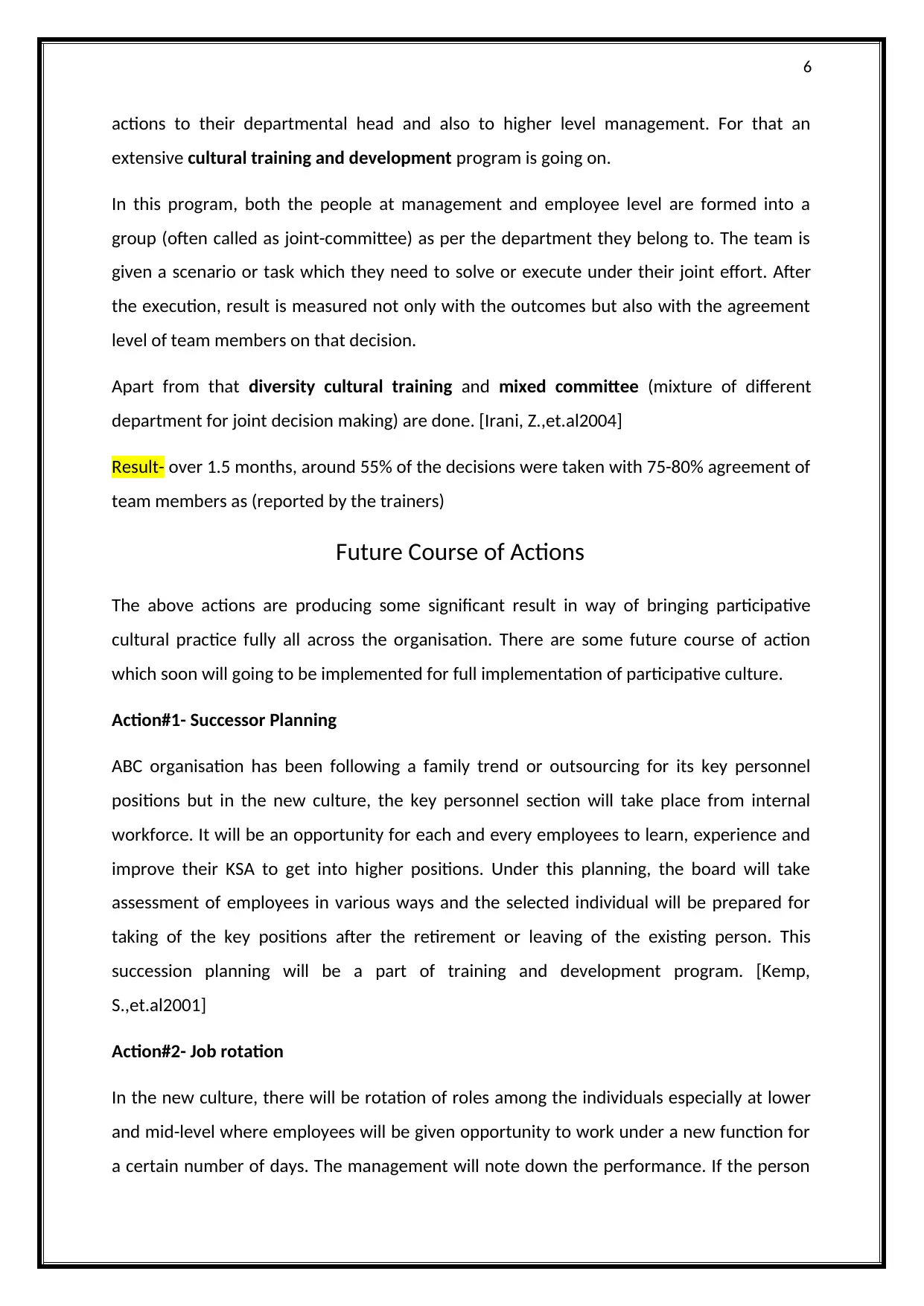
6
actions to their departmental head and also to higher level management. For that an
extensive cultural training and development program is going on.
In this program, both the people at management and employee level are formed into a
group (often called as joint-committee) as per the department they belong to. The team is
given a scenario or task which they need to solve or execute under their joint effort. After
the execution, result is measured not only with the outcomes but also with the agreement
level of team members on that decision.
Apart from that diversity cultural training and mixed committee (mixture of different
department for joint decision making) are done. [Irani, Z.,et.al2004]
Result- over 1.5 months, around 55% of the decisions were taken with 75-80% agreement of
team members as (reported by the trainers)
Future Course of Actions
The above actions are producing some significant result in way of bringing participative
cultural practice fully all across the organisation. There are some future course of action
which soon will going to be implemented for full implementation of participative culture.
Action#1- Successor Planning
ABC organisation has been following a family trend or outsourcing for its key personnel
positions but in the new culture, the key personnel section will take place from internal
workforce. It will be an opportunity for each and every employees to learn, experience and
improve their KSA to get into higher positions. Under this planning, the board will take
assessment of employees in various ways and the selected individual will be prepared for
taking of the key positions after the retirement or leaving of the existing person. This
succession planning will be a part of training and development program. [Kemp,
S.,et.al2001]
Action#2- Job rotation
In the new culture, there will be rotation of roles among the individuals especially at lower
and mid-level where employees will be given opportunity to work under a new function for
a certain number of days. The management will note down the performance. If the person
actions to their departmental head and also to higher level management. For that an
extensive cultural training and development program is going on.
In this program, both the people at management and employee level are formed into a
group (often called as joint-committee) as per the department they belong to. The team is
given a scenario or task which they need to solve or execute under their joint effort. After
the execution, result is measured not only with the outcomes but also with the agreement
level of team members on that decision.
Apart from that diversity cultural training and mixed committee (mixture of different
department for joint decision making) are done. [Irani, Z.,et.al2004]
Result- over 1.5 months, around 55% of the decisions were taken with 75-80% agreement of
team members as (reported by the trainers)
Future Course of Actions
The above actions are producing some significant result in way of bringing participative
cultural practice fully all across the organisation. There are some future course of action
which soon will going to be implemented for full implementation of participative culture.
Action#1- Successor Planning
ABC organisation has been following a family trend or outsourcing for its key personnel
positions but in the new culture, the key personnel section will take place from internal
workforce. It will be an opportunity for each and every employees to learn, experience and
improve their KSA to get into higher positions. Under this planning, the board will take
assessment of employees in various ways and the selected individual will be prepared for
taking of the key positions after the retirement or leaving of the existing person. This
succession planning will be a part of training and development program. [Kemp,
S.,et.al2001]
Action#2- Job rotation
In the new culture, there will be rotation of roles among the individuals especially at lower
and mid-level where employees will be given opportunity to work under a new function for
a certain number of days. The management will note down the performance. If the person
⊘ This is a preview!⊘
Do you want full access?
Subscribe today to unlock all pages.

Trusted by 1+ million students worldwide
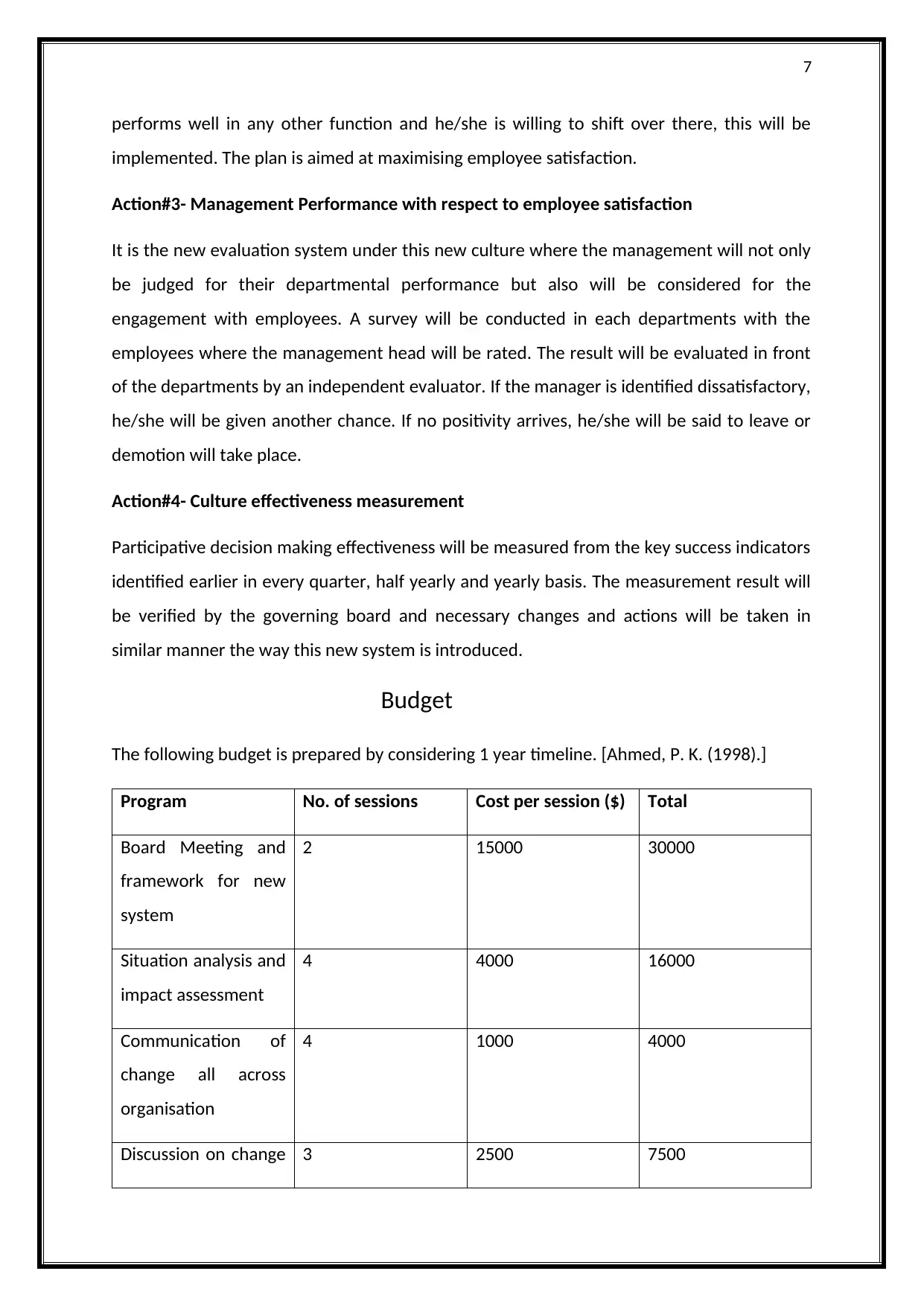
7
performs well in any other function and he/she is willing to shift over there, this will be
implemented. The plan is aimed at maximising employee satisfaction.
Action#3- Management Performance with respect to employee satisfaction
It is the new evaluation system under this new culture where the management will not only
be judged for their departmental performance but also will be considered for the
engagement with employees. A survey will be conducted in each departments with the
employees where the management head will be rated. The result will be evaluated in front
of the departments by an independent evaluator. If the manager is identified dissatisfactory,
he/she will be given another chance. If no positivity arrives, he/she will be said to leave or
demotion will take place.
Action#4- Culture effectiveness measurement
Participative decision making effectiveness will be measured from the key success indicators
identified earlier in every quarter, half yearly and yearly basis. The measurement result will
be verified by the governing board and necessary changes and actions will be taken in
similar manner the way this new system is introduced.
Budget
The following budget is prepared by considering 1 year timeline. [Ahmed, P. K. (1998).]
Program No. of sessions Cost per session ($) Total
Board Meeting and
framework for new
system
2 15000 30000
Situation analysis and
impact assessment
4 4000 16000
Communication of
change all across
organisation
4 1000 4000
Discussion on change 3 2500 7500
performs well in any other function and he/she is willing to shift over there, this will be
implemented. The plan is aimed at maximising employee satisfaction.
Action#3- Management Performance with respect to employee satisfaction
It is the new evaluation system under this new culture where the management will not only
be judged for their departmental performance but also will be considered for the
engagement with employees. A survey will be conducted in each departments with the
employees where the management head will be rated. The result will be evaluated in front
of the departments by an independent evaluator. If the manager is identified dissatisfactory,
he/she will be given another chance. If no positivity arrives, he/she will be said to leave or
demotion will take place.
Action#4- Culture effectiveness measurement
Participative decision making effectiveness will be measured from the key success indicators
identified earlier in every quarter, half yearly and yearly basis. The measurement result will
be verified by the governing board and necessary changes and actions will be taken in
similar manner the way this new system is introduced.
Budget
The following budget is prepared by considering 1 year timeline. [Ahmed, P. K. (1998).]
Program No. of sessions Cost per session ($) Total
Board Meeting and
framework for new
system
2 15000 30000
Situation analysis and
impact assessment
4 4000 16000
Communication of
change all across
organisation
4 1000 4000
Discussion on change 3 2500 7500
Paraphrase This Document
Need a fresh take? Get an instant paraphrase of this document with our AI Paraphraser
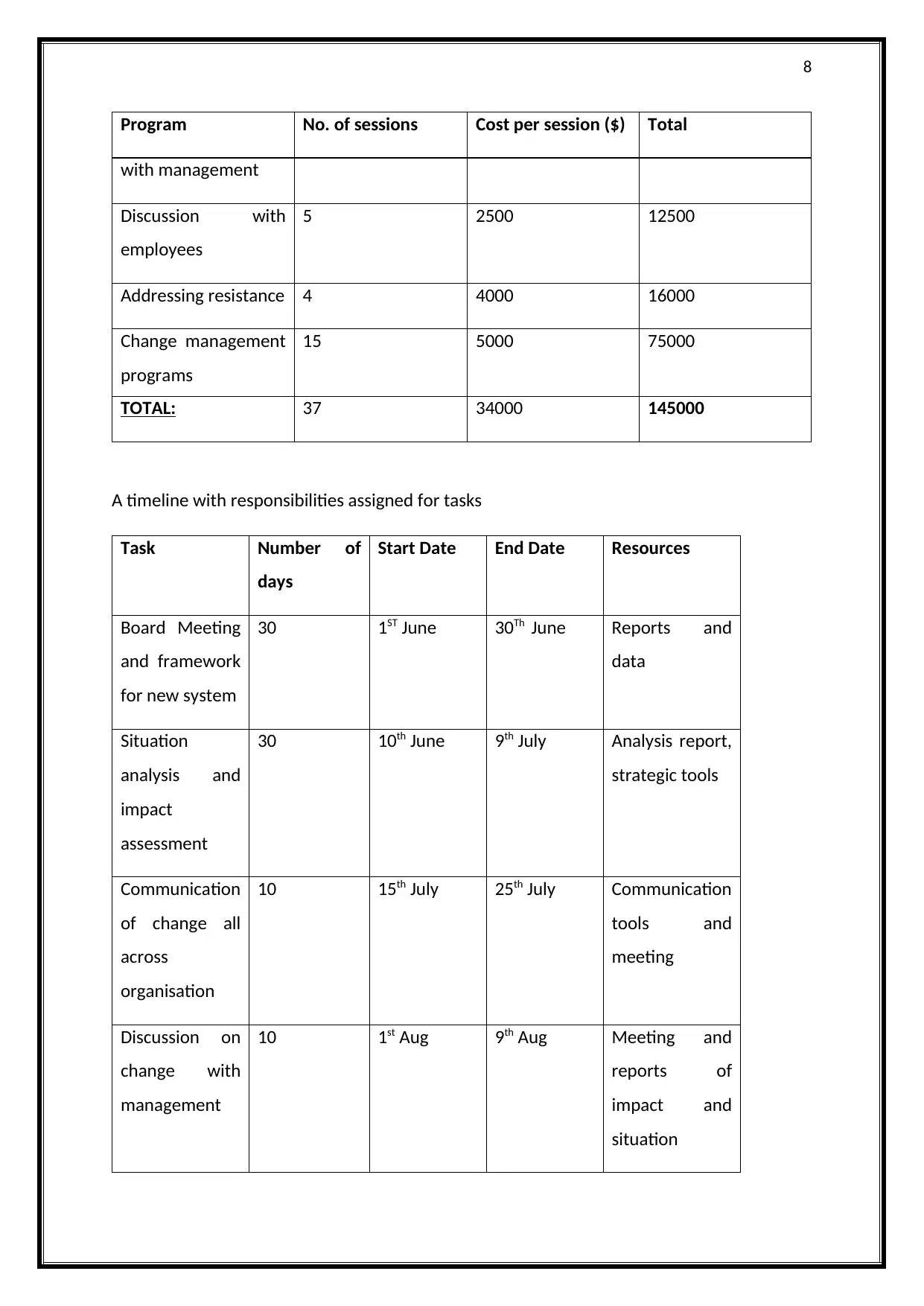
8
Program No. of sessions Cost per session ($) Total
with management
Discussion with
employees
5 2500 12500
Addressing resistance 4 4000 16000
Change management
programs
15 5000 75000
TOTAL: 37 34000 145000
A timeline with responsibilities assigned for tasks
Task Number of
days
Start Date End Date Resources
Board Meeting
and framework
for new system
30 1ST June 30Th June Reports and
data
Situation
analysis and
impact
assessment
30 10th June 9th July Analysis report,
strategic tools
Communication
of change all
across
organisation
10 15th July 25th July Communication
tools and
meeting
Discussion on
change with
management
10 1st Aug 9th Aug Meeting and
reports of
impact and
situation
Program No. of sessions Cost per session ($) Total
with management
Discussion with
employees
5 2500 12500
Addressing resistance 4 4000 16000
Change management
programs
15 5000 75000
TOTAL: 37 34000 145000
A timeline with responsibilities assigned for tasks
Task Number of
days
Start Date End Date Resources
Board Meeting
and framework
for new system
30 1ST June 30Th June Reports and
data
Situation
analysis and
impact
assessment
30 10th June 9th July Analysis report,
strategic tools
Communication
of change all
across
organisation
10 15th July 25th July Communication
tools and
meeting
Discussion on
change with
management
10 1st Aug 9th Aug Meeting and
reports of
impact and
situation
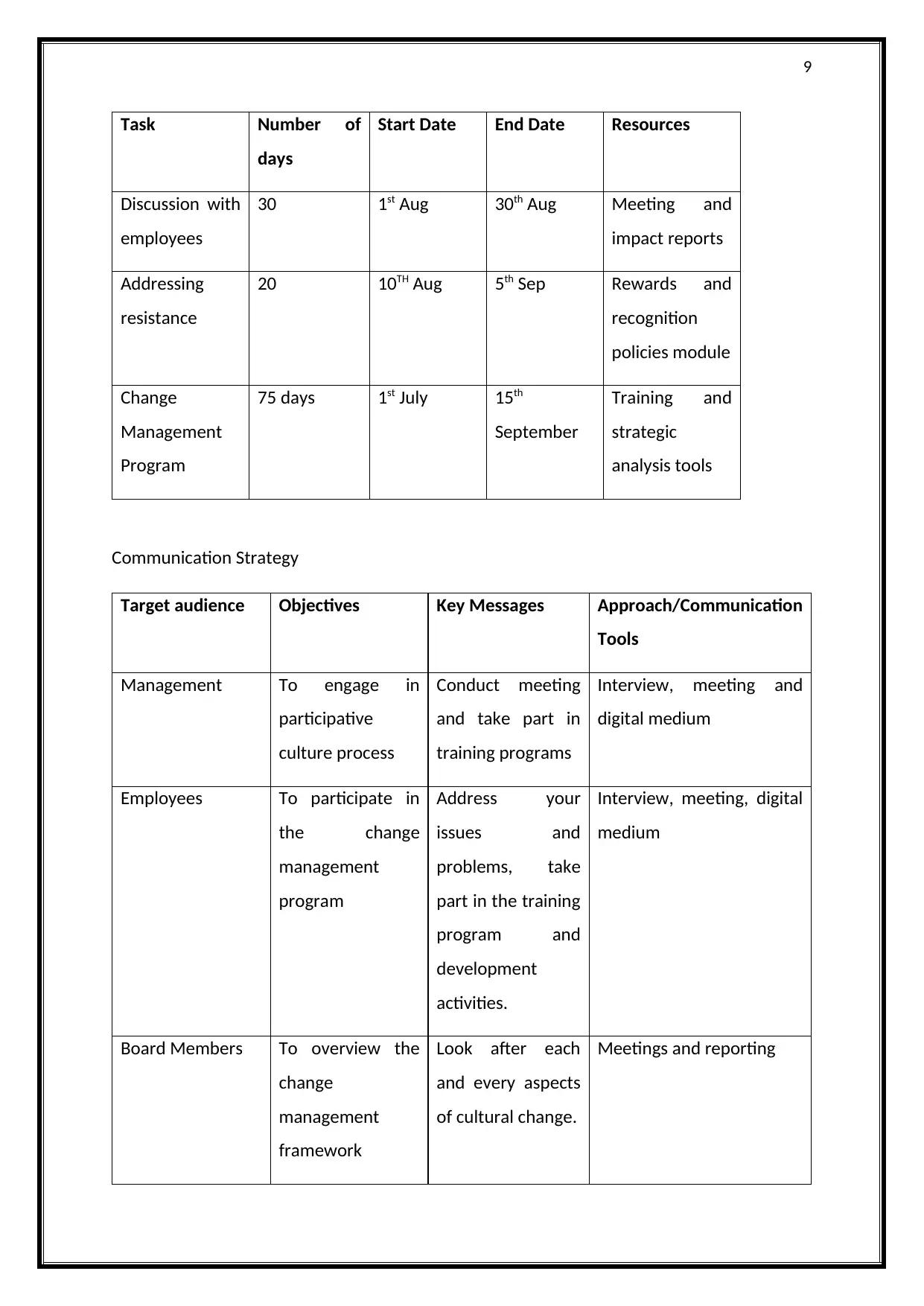
9
Task Number of
days
Start Date End Date Resources
Discussion with
employees
30 1st Aug 30th Aug Meeting and
impact reports
Addressing
resistance
20 10TH Aug 5th Sep Rewards and
recognition
policies module
Change
Management
Program
75 days 1st July 15th
September
Training and
strategic
analysis tools
Communication Strategy
Target audience Objectives Key Messages Approach/Communication
Tools
Management To engage in
participative
culture process
Conduct meeting
and take part in
training programs
Interview, meeting and
digital medium
Employees To participate in
the change
management
program
Address your
issues and
problems, take
part in the training
program and
development
activities.
Interview, meeting, digital
medium
Board Members To overview the
change
management
framework
Look after each
and every aspects
of cultural change.
Meetings and reporting
Task Number of
days
Start Date End Date Resources
Discussion with
employees
30 1st Aug 30th Aug Meeting and
impact reports
Addressing
resistance
20 10TH Aug 5th Sep Rewards and
recognition
policies module
Change
Management
Program
75 days 1st July 15th
September
Training and
strategic
analysis tools
Communication Strategy
Target audience Objectives Key Messages Approach/Communication
Tools
Management To engage in
participative
culture process
Conduct meeting
and take part in
training programs
Interview, meeting and
digital medium
Employees To participate in
the change
management
program
Address your
issues and
problems, take
part in the training
program and
development
activities.
Interview, meeting, digital
medium
Board Members To overview the
change
management
framework
Look after each
and every aspects
of cultural change.
Meetings and reporting
⊘ This is a preview!⊘
Do you want full access?
Subscribe today to unlock all pages.

Trusted by 1+ million students worldwide
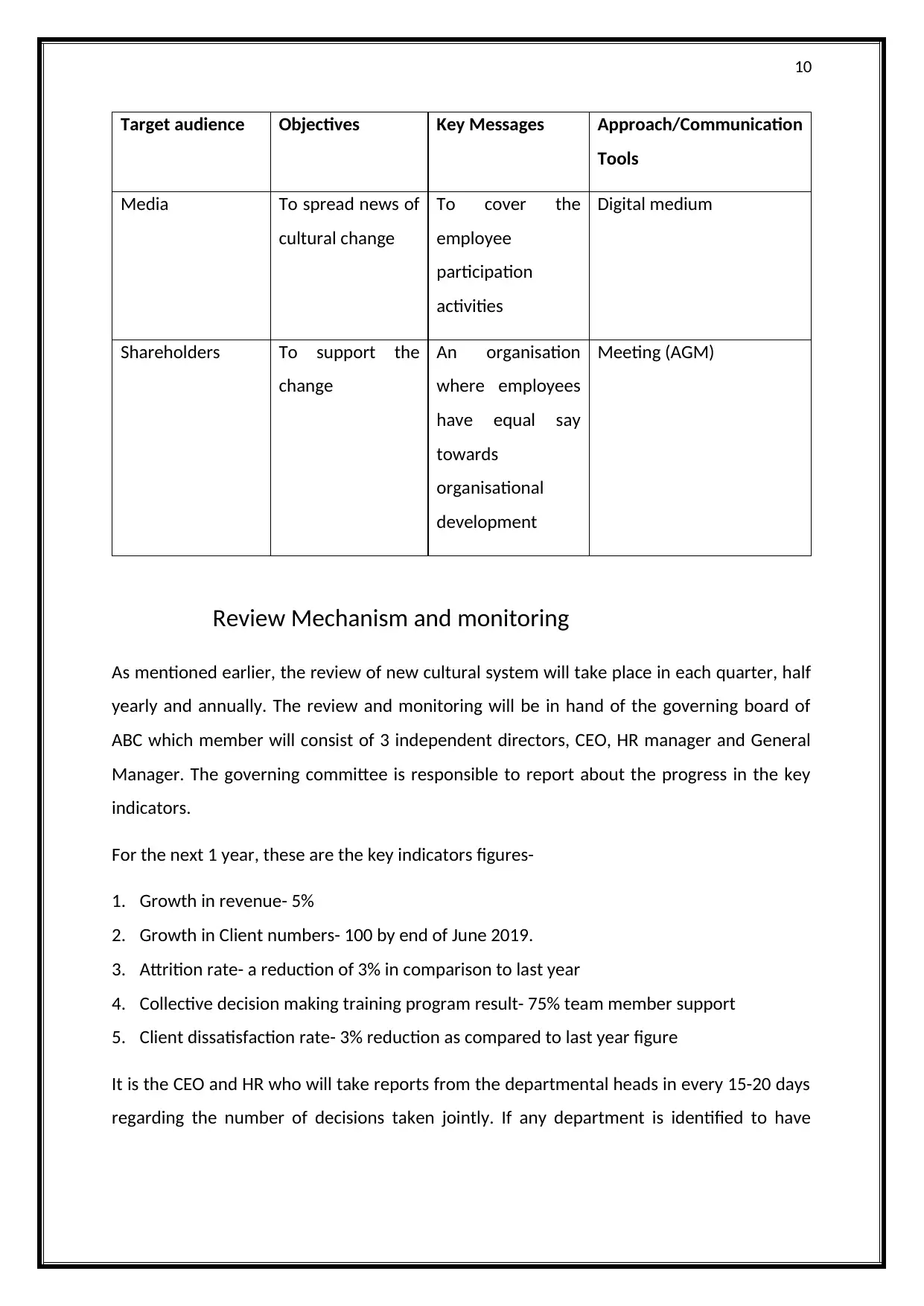
10
Target audience Objectives Key Messages Approach/Communication
Tools
Media To spread news of
cultural change
To cover the
employee
participation
activities
Digital medium
Shareholders To support the
change
An organisation
where employees
have equal say
towards
organisational
development
Meeting (AGM)
Review Mechanism and monitoring
As mentioned earlier, the review of new cultural system will take place in each quarter, half
yearly and annually. The review and monitoring will be in hand of the governing board of
ABC which member will consist of 3 independent directors, CEO, HR manager and General
Manager. The governing committee is responsible to report about the progress in the key
indicators.
For the next 1 year, these are the key indicators figures-
1. Growth in revenue- 5%
2. Growth in Client numbers- 100 by end of June 2019.
3. Attrition rate- a reduction of 3% in comparison to last year
4. Collective decision making training program result- 75% team member support
5. Client dissatisfaction rate- 3% reduction as compared to last year figure
It is the CEO and HR who will take reports from the departmental heads in every 15-20 days
regarding the number of decisions taken jointly. If any department is identified to have
Target audience Objectives Key Messages Approach/Communication
Tools
Media To spread news of
cultural change
To cover the
employee
participation
activities
Digital medium
Shareholders To support the
change
An organisation
where employees
have equal say
towards
organisational
development
Meeting (AGM)
Review Mechanism and monitoring
As mentioned earlier, the review of new cultural system will take place in each quarter, half
yearly and annually. The review and monitoring will be in hand of the governing board of
ABC which member will consist of 3 independent directors, CEO, HR manager and General
Manager. The governing committee is responsible to report about the progress in the key
indicators.
For the next 1 year, these are the key indicators figures-
1. Growth in revenue- 5%
2. Growth in Client numbers- 100 by end of June 2019.
3. Attrition rate- a reduction of 3% in comparison to last year
4. Collective decision making training program result- 75% team member support
5. Client dissatisfaction rate- 3% reduction as compared to last year figure
It is the CEO and HR who will take reports from the departmental heads in every 15-20 days
regarding the number of decisions taken jointly. If any department is identified to have
Paraphrase This Document
Need a fresh take? Get an instant paraphrase of this document with our AI Paraphraser
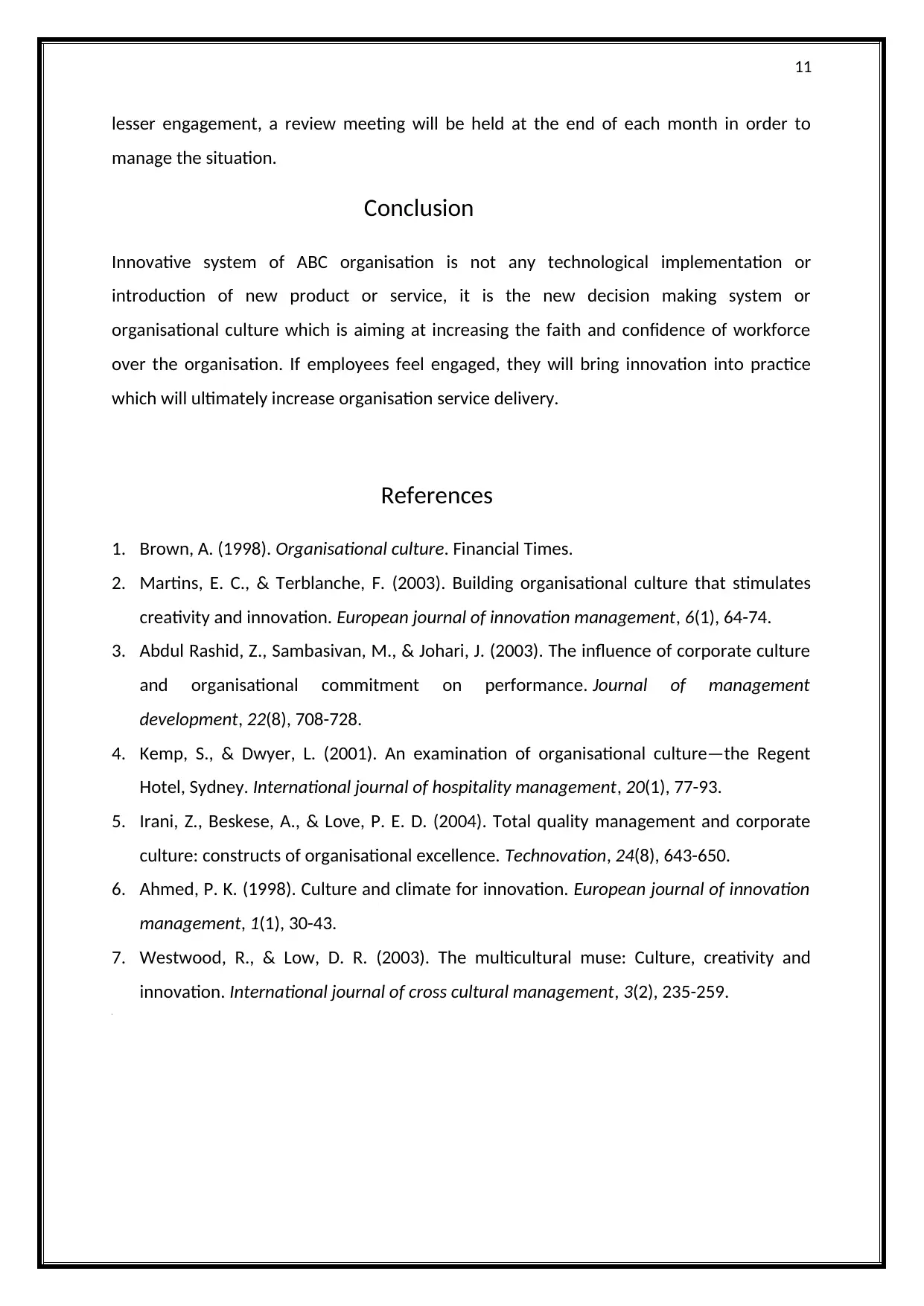
11
lesser engagement, a review meeting will be held at the end of each month in order to
manage the situation.
Conclusion
Innovative system of ABC organisation is not any technological implementation or
introduction of new product or service, it is the new decision making system or
organisational culture which is aiming at increasing the faith and confidence of workforce
over the organisation. If employees feel engaged, they will bring innovation into practice
which will ultimately increase organisation service delivery.
References
1. Brown, A. (1998). Organisational culture. Financial Times.
2. Martins, E. C., & Terblanche, F. (2003). Building organisational culture that stimulates
creativity and innovation. European journal of innovation management, 6(1), 64-74.
3. Abdul Rashid, Z., Sambasivan, M., & Johari, J. (2003). The influence of corporate culture
and organisational commitment on performance. Journal of management
development, 22(8), 708-728.
4. Kemp, S., & Dwyer, L. (2001). An examination of organisational culture—the Regent
Hotel, Sydney. International journal of hospitality management, 20(1), 77-93.
5. Irani, Z., Beskese, A., & Love, P. E. D. (2004). Total quality management and corporate
culture: constructs of organisational excellence. Technovation, 24(8), 643-650.
6. Ahmed, P. K. (1998). Culture and climate for innovation. European journal of innovation
management, 1(1), 30-43.
7. Westwood, R., & Low, D. R. (2003). The multicultural muse: Culture, creativity and
innovation. International journal of cross cultural management, 3(2), 235-259.
8.
lesser engagement, a review meeting will be held at the end of each month in order to
manage the situation.
Conclusion
Innovative system of ABC organisation is not any technological implementation or
introduction of new product or service, it is the new decision making system or
organisational culture which is aiming at increasing the faith and confidence of workforce
over the organisation. If employees feel engaged, they will bring innovation into practice
which will ultimately increase organisation service delivery.
References
1. Brown, A. (1998). Organisational culture. Financial Times.
2. Martins, E. C., & Terblanche, F. (2003). Building organisational culture that stimulates
creativity and innovation. European journal of innovation management, 6(1), 64-74.
3. Abdul Rashid, Z., Sambasivan, M., & Johari, J. (2003). The influence of corporate culture
and organisational commitment on performance. Journal of management
development, 22(8), 708-728.
4. Kemp, S., & Dwyer, L. (2001). An examination of organisational culture—the Regent
Hotel, Sydney. International journal of hospitality management, 20(1), 77-93.
5. Irani, Z., Beskese, A., & Love, P. E. D. (2004). Total quality management and corporate
culture: constructs of organisational excellence. Technovation, 24(8), 643-650.
6. Ahmed, P. K. (1998). Culture and climate for innovation. European journal of innovation
management, 1(1), 30-43.
7. Westwood, R., & Low, D. R. (2003). The multicultural muse: Culture, creativity and
innovation. International journal of cross cultural management, 3(2), 235-259.
8.
1 out of 11
Related Documents
Your All-in-One AI-Powered Toolkit for Academic Success.
+13062052269
info@desklib.com
Available 24*7 on WhatsApp / Email
![[object Object]](/_next/static/media/star-bottom.7253800d.svg)
Unlock your academic potential
Copyright © 2020–2025 A2Z Services. All Rights Reserved. Developed and managed by ZUCOL.





